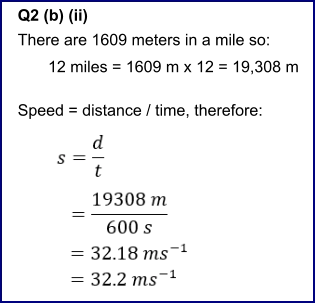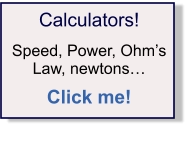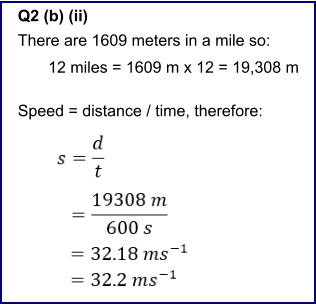
Mathematics is communication as well as computation
There are many times when we simply need an answer and a quickly scribbled equation on a scrap of paper is good
enough. However, we may be preparing work for other reasons, such as an assignment or a report. The key word is
communication. Here, we will see how to communicate mathematical work clearly, neatly and professionally.



Presentation

We learn from seeing things done well, but we can often learn a great deal by recognizing errors in
poor work. Both good and bad examples are presented below, both being answers to this question:
Q2 (b) (ii) - 12 miles = 1609 = 19308. s = 19308/600 = 32.18 ms-1
A careful reading of the question offers important information and some tips on how to answer and
present it, and we will come back to these, but here is one student’s answer:
Q2 (b) (ii)
A car travels 12 miles in 600 seconds. What is its speed to 1
decimal place? Take 1 mile to equal 1609 meters. 4 marks.
As answers go, this is a very poor one, even if the final answer is (partly) correct. Let’s see what’s wrong with it:
The answer label isn’t clear. Is Q2 (b) (ii) the label or part of the question?
It looks like the figure 12 could actually be -12.
There’s no context. For example what does 1609 mean? It may be obvious, but still needs to be stated.
As above, most of the values don’t have units. Units should always be included if available.
The work is all on one line. This makes reading and writing errors more likely.
The answer was given to 2 decimal places, and not 1 as asked for in the question.
The -1 at the end should be in superscript: ms-1 and ms
-1
mean different things.
The problems here are mostly of poor communication. The work comes across as uncaring and lazy, and if
submitted as part of an assignment would likely receive a reduced mark. We can easily improve on this.


A much better answer

With a little thought and practise we can easily produce much better work. Here’s another version of the answer:
Points to note:
The answer label is clear and easy to see at a glance.
The student has reminded the reader of how many meters there are in mile.
This has added context and is good communication.
All of the values have units included, and the correct index format for ms
-1
has been used.
All the letters are defined before they are used, such as s, d and t.
The indenting of parts helps to split areas into easily focused sections. Lots of “white space” also helps.
The equation is aligned at the equals sign.

This is much better communication and much more likely to receive full marks.

Presenting mathematical work well takes a little thought and practise. There often isn’t a single right way, but there
are very many wrongs ways. Here are some ideas and points to consider:
Some final advice and tips
Presenting mathematical work well takes a little thought and practise. There often isn’t a single right way,
but there are very many wrongs ways. Here are some ideas and points to consider:
Use lots of “white space” such as blank lines between sections. This really improves the presentation. No
one likes reading tightly packed mathematical work.
Always go back over the question afterwards to check that the key words and tasks have been addressed.
One of the most common errors is giving answers to the wrong number of decimal places.
Always take a moment to consider if your answer makes sense or not. The answer above of 32.2 ms
-1
,
being about 70 mph, is fast, but easily possible for most cars. If the speed came out at 3000 ms
-1
(about
6,700 mph), for example, then it’s likely that there’s a mistake in the work.
The equations shown here are examples, but your teacher may have preferences for how work is to be
presented. If you’re not sure, ask.
Consider making a check-list that you can refer to in order to avoid errors, or keep this page open as you
work and glance at it from time to time to remind yourself of certain points.
Finally, remember that the single most important word in presenting mathematical work is communication.


Advertisement


Presentation

Mathematics is communication as well as computation
There are many times when we simply need an answer and a
quickly scribbled equation on a scrap of paper is good enough.
However, we may be preparing work for other reasons, such as
an assignment or a report. The key word is communication.
Here, we will see how to communicate mathematical work clearly,
neatly and professionally.

We learn from seeing things done well, but we can often learn a
great deal by recognizing errors in poor work. Both good and bad
examples are presented below, both being answers to this
question:
Q2 (b) (ii)
A car travels 12 miles in 600 seconds. What is its speed to 1
decimal place? Take 1 mile to equal 1609 meters. 4 marks.


As answers go, this is a very poor one, even if the final answer is
(partly) correct. Let’s see what’s wrong with it:
The answer label isn’t clear. Is Q2 (b) (ii) the label or
part of the question?
It looks like the figure 12 could actually be -12.
There’s no context. For example what does 1609
mean? It may be obvious, but still needs to be stated.
As above, most of the values don’t have units. Units
should always be included if available.
The work is all on one line. This makes reading and
writing errors more likely.
The answer was given to 2 decimal places, and not 1
as asked for in the question.
The -1 at the end should be in superscript: ms-1 and
ms
-1
mean different things.

The problems here are mostly of poor communication. The
work comes across as uncaring and lazy, and if submitted as
part of an assignment would likely receive a reduced mark. We
can easily improve on this.
A much better answer
Advertisement


With a little thought and practise we can easily produce much
better work. Here’s another version of the answer:

Points to note:
The answer label is clear and easy to see at a glance.
The student has reminded the reader of how many
meters there are in mile.
This has added context and is good communication.
All of the values have units included, and the correct
index format for ms
-1
has been used.
All the letters are defined before they are used, such as
s, d and t.
The indenting of parts helps to split areas into easily
focused sections. Lots of “white space” also helps.
The equation is aligned at the equals sign.







This is much better communication and much more likely to
receive full marks.

Some final advice and tips
Presenting mathematical work well takes a little thought and
practise. There often isn’t a single right way, but there are very
many wrongs ways. Here are some ideas and points to consider:
Presenting mathematical work well takes a little thought
and practise. There often isn’t a single right way, but there
are very many wrongs ways. Here are some ideas and
points to consider:
Use lots of “white space” such as blank lines between
sections. This really improves the presentation. No one
likes reading tightly packed mathematical work.
Always go back over the question afterwards to check that
the key words and tasks have been addressed. One of the
most common errors is giving answers to the wrong
number of decimal places.
Always take a moment to consider if your answer makes
sense or not. The answer above of 32.2 ms
-1
, being about
70 mph, is fast, but easily possible for most cars. If the
speed came out at 3000 ms
-1
(about 6,700 mph), for
example, then it’s likely that there’s a mistake in the work.
The equations shown here are examples, but your teacher
may have preferences for how work is to be presented. If
you’re not sure, ask.
Consider making a check-list that you can refer to in order
to avoid errors, or keep this page open as you work and
glance at it from time to time to remind yourself of certain
points.
Finally, remember that the single most important word in
presenting mathematical work is communication.




